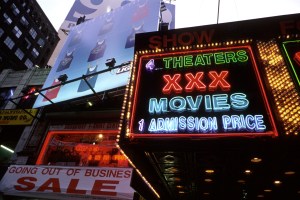Lisa Steinberg was just a few months out of college when she was bound, gagged and stabbed to death in the office of a Gap store on West 57th Street near Broadway. It was January of 1992, halfway through David Dinkin’s only term as mayor of an increasingly anarchic and crime-plagued New York.
The murder rate had peaked at 2,245 in 1990. But the number of homicides climbed in the Midtown South precinct—which includes Times Square—reaching 11 in 1993. East New York’s 75th precinct broke the record that year for the most murders in a single precinct: 126.
 That was also the year Colin Ferguson killed six people and injured 19 others during a shooting rampage on the Long Island Railroad. An Indian prince and his wife were found dead in their Park Avenue apartment, victims of either a double homicide or murder-suicide. And thousands of taxi drivers formed a caravan that crippled Manhattan traffic as they protested the 35th murder of a cabdriver that year and the NYC Taxi & Limousine Commission’s inability to enhance protection.
That was also the year Colin Ferguson killed six people and injured 19 others during a shooting rampage on the Long Island Railroad. An Indian prince and his wife were found dead in their Park Avenue apartment, victims of either a double homicide or murder-suicide. And thousands of taxi drivers formed a caravan that crippled Manhattan traffic as they protested the 35th murder of a cabdriver that year and the NYC Taxi & Limousine Commission’s inability to enhance protection.
Twenty years later, West Midtown between 57th and 42nd Streets is a radically transformed neighborhood whose peep shows, pickpockets and hookers have given way to Disney musicals, double-decker tourist buses and Elmo impersonators. Marquee office and retail tenants have flooded into skyscrapers erected following a mid-’80s upzoning and public-private reinvestment in 42nd Street and neighboring corridors.
Yet the current mayor’s race has taken a turn toward bitter nostalgia, with the underdog Republican candidate, Joe Lhota, loudly suggesting that the progressive favorite Bill de Blasio will go lax on crime, restoring lawlessness and disorder to the five boroughs. On Oct. 16, the Lhota campaign released a 30-second video ad rife with stock footage of police tape, graffiti-caked subways, muggers and police in riot gear. “Bill de Blasio’s recklessly dangerous agenda on crime will take us back to this,” the ad warns before the torrent of despair.
While injecting the subject of commercial real estate into a discussion of murder, rape and robbery might seem callous, the industry is paying attention to Mr. Lhota’s alarms, even if some players are skeptical of resurgent grit undoing two decades of major gains.
“Times Square is here to stay,” said Faith Hope Consolo, of the retail group at Douglas Elliman. The famously outspoken Ms. Consolo featured prominently in Dinkens-era media reports of a nascent Times Square renaissance. But the woman who worked on high-profile Times Square comeback leases such as the Toys “R” Us deal on Broadway recalled some crafty maneuvering to convince retail tenants of the still-seedy area’s long-term viability.
“Someone on my team was showing space on 42nd Street,” she said. “We were telling everybody: ‘This is coming; that is coming.’ But retailers don’t buy futures. There were a lot of vagrants. And forget about the hookers. So I gave one broker a roll of $100 in singles. He’d ask [the vagrants] to move, and, if they did, he’d give them a buck for coffee. By the fourth week of doing this, we’d moved people four blocks away from the site.”
As the less savory elements of the Times Square population moved away from the Bowtie—even if only to Eighth Avenue—increasingly impressive corporate and retail tenants moved in. In part, that was due to a massive spike in total available space. Richard Persichetti, the vice president of research, marketing and consulting at Cassidy Turley, said that at the end of 1993, there was 10 million square feet of real estate in Times Square compared to 18 million square feet today. The average asking rent across all building classes in 1993 was $18 per square foot. Today, that number stands at $78.25.
James Delmonte, the director of research at Cushman & Wakefield, supplied numbers stretching back to 1995, when the Times Square South submarket had a vacancy rate of 16.8 percent. There was 1,136,862 square feet of leasing activity in 1996. That number nearly tripled, to 3,095,004 square feet, the following year. In the third quarter of this year, the Times Square South vacancy rate stood at 9.2 percent.
Real estate brokers who were instrumental in the Times Square renaissance singled out a handful of developments and leases chiefly responsible for the turnaround. One was Disney’s lease in 1993 of the faded New Amsterdam Theatre on 42nd Street. That victory for the city and state’s ambitious 42nd Street Development Project—a plan to reinvigorate 13 acres of the then-infamous boulevard with four giant office towers and refurbished entertainment venues—brought an almost comically dissonant “fixer” to porn row.
“That was a stamp of approval,” Ms. Consolo said. “Then we had the new developments,” including [the Durst Organization’s] 4 Times Square, which opened in 1999 as the home of Condé Nast. “Durst was the bell cow with 4 Times Square,” said Robert Futterman, the chairman and chief executive of the retail brokerage RKF. “That was the biggest game-changer.” He cited 1585 Broadway, the Thompson Reuters Building and 2 Times Square as other paradigm shifters.


